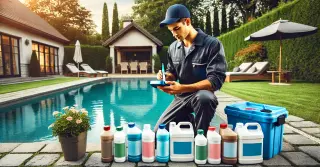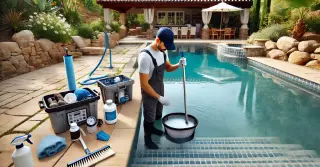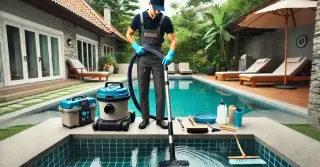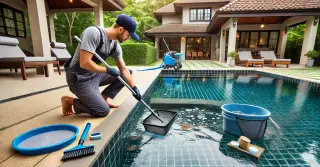Pool Chemical Balance Charlotte County FL

Ensuring the right chemical balance is crucial for a safe and healthy swimming environment. Balanced chemicals inhibit algae and bacteria, ensure clear water and protect pool surfaces and equipment.
- Maintaining Proper pH: The pH balance in your pool reflects its acidity or alkalinity. Optimal pH levels range from 7.2 to 7.6. If the pH is too low, the water becomes acidic, which can cause skin irritation and corrosion of pool equipment. If the pH is too high, the water becomes alkaline, leading to cloudy water and scaling on the pool surfaces. Regularly testing and adjusting the pH levels is essential to maintain a comfortable and safe swimming environment.
- Keeping Chlorine Balanced: Chlorine plays a crucial role in pool sanitation, as it kills bacteria, algae, and other harmful microorganisms. The ideal chlorine level should be between 1-3 ppm (parts per million). Low chlorine levels cause unsanitary water, with bacteria and algae proliferating. Too much chlorine can cause skin and eye irritation and create a strong chlorine smell. Consistently monitoring and adjusting chlorine levels ensures sanitation and comfort.
Managing Total AlkalinityTotal alkalinity plays a vital role in pool water balance. Alkalinity stabilizes pH levels, helping to prevent drastic changes in pH. The ideal range for total alkalinity is between 80-120 ppm.
- Stabilizing pH Levels: Proper alkalinity levels help stabilize pH levels, preventing rapid pH shifts that cause skin irritation and surface damage. Low alkalinity results in unstable pH levels, making consistent balance difficult. If alkalinity is too high, it can make the water cloudy and lead to scaling. Frequent alkalinity testing and adjustments is crucial for stable and balanced water.
- Managing Calcium Hardness: Calcium hardness refers to the amount of dissolved calcium in the pool water. The ideal range for calcium hardness is between 200-400 ppm. Insufficient calcium causes corrosive water, damaging surfaces and equipment. If calcium levels are too high, it can cause scaling on pool surfaces and cloud the water. Consistently monitoring and adjusting calcium hardness is important for protecting your pool and ensuring clear water.
Using Pool Chemicals SafelyProper handling and storage of pool chemicals is vital for safety and chemical performance. Keep chemicals in a cool, dry location, away from direct sunlight and out of reach of children and pets. Follow the manufacturer's instructions for correct dosing and application.
- Accurate Chemical Measurement and Mixing: Accurately measuring pool chemicals is essential to maintain the proper balance. Using too much or too little can imbalance chemicals and harm water quality. Use a clean, dry measuring cup or scoop and never mix chemicals directly with each other. Mix chemicals in water if required, following the instructions carefully.
- Understanding Chemical Reactions: Certain chemicals can react dangerously if mixed. For instance, never mix chlorine and acid. Knowing these interactions prevents accidents and ensures safe handling. Store chemicals separately and handle each with care to prevent harmful reactions.
Ensuring the right chemical balance in your pool is essential for a safe, clean, and enjoyable swimming environment. By regularly testing and adjusting pH, chlorine, alkalinity, and calcium levels, you can keep your pool water in optimal condition.
Proper chemical use and storage enhance the health and safety of your pool.




